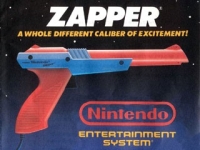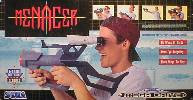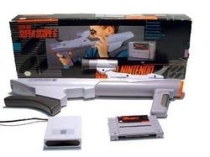Special: Good... Bad... I'm the guy with the Light Gun.
The Light Gun has always been the forgotten stepchild when it comes to video game accessories. A Light Gun has been produced for nearly every system since the birth of home video gaming in the 1972, but they quickly fall by the wayside as game support dries up. Even the famed NES Zapper was only supported by roughly a dozen games.
But the story of "light guns" goes back even further than that. In 1936, a company named Seeburg released the Seeburg Ray-O-Lite, a carnival game that used light-sensing tubes to recreate a shooting gallery. Interestingly enough, what the Ray-O-Lite recreated was a duck hunt with a light shooting rifle and a duck that flew around with a light-sensor attached to it. When the duck was shot, it would fall.
The first Light Gun available for a home video game system actually came with the first home video game system. The Magnavox Odyssey "Shooting Gallery" gun was released in 1972 and was shaped like a hunting rifle. It came with four games: Dogfight, Prehistoric Safari, Shootout and Shooting Gallery. A nasty rumor quickly spread that said the Shooting Gallery would only work with Magnavox televisions and sales never really recovered. The rumor was untrue, but it has made the Shooting Gallery a very rare piece of video game history.
Now you're playing with power...

The first mainstream Light Gun has also become the most recognized and I, of course, speak of the NES Zapper. The Zapper was a Star Wars-inspired laser blaster that featured a gray barrel and a dark gray grip to match the styling of the original NES. It came packaged with the NES (along with R.O.B.) in all of Nintendo's early systems to create a total package of entertainment. The sleek gray blaster's iconic design has been used as the inspiration for many subsequent Light Guns. But many people are unaware that the original design for the Zapper (the one released in Japan in 1985) was an old west-styled six shooter.
While the Zapper did not receive great support over the life of the NES, it's legacy lives in several classics including Duck Hunt, the police trainer Hogan's Alley, carnival game collection Barker Bill's Trick Shooting and the gory graveyard shooter Chiller (which, sadly, was an unlicensed game and will probably never be re-released). The best remembered of these is the launch title Duck Hunt. Packaged with nearly every variation of the system, everyone has played Duck Hunt and everyone has wished vile things to happen to that snickering dog. Amazingly, Nintendo brought the dog back in Barker Bill's Trick Shooting. And not only that, but you could shoot him!

In the late 80s, the Zapper was retooled into a gray and orange model to come into compliance with a new federal law concerning "realistic" toy guns. Many toy guns only required an orange cap on the end, but many game makers choose to take it a step further and outfitted many future Light Guns in outrageous and space age designs. It was this design that was used by one of Nintendo's first cartoon superheroes, Captain N. He was sucked into Videoland by his TV and every week from 1989 to 1993 he saved Videoland from the Mother Brain, Dr. Wily, the Eggplant Wizard and King Hippo. The cartoon, like the Zapper, is remembered fondly. The Zapper's distinctive click, actually a spring in the trigger, has kept it popular to this day as a Halloween accessory.
After the Zapper proved to be a hit, Atari created a similar looking piece of equipment, the XG-1, for the Atari XEGS gaming computer Atari 7800. Released in 1987, the XG-1 is little more than a footnote to history, and many people are surprised to hear Atari even released a Light Gun, but it is notable as one of the first times Nintendo steps up and completely blows away the competition with an innovative idea.
When Sega released their Master System the same year, they packed in the Light Phaser, cementing the idea that a Light Gun is a required piece of equipment for a console. Like the Atari XG-1, the Light Phaser had little impact on the Master System's library. The black blaster (actually based on a weapon from the anime Zillion) was one of the last toy guns to get away with a "realistic" look before the US laws on toy guns required a slight redesign. The orange-tipped "safety" version is actually a hard-to-find collectible.
The 16-Bit Era

The next generation of Light Gun designs abandoned the blaster shape and took on a more futuristic military aesthetic (possibly in response to the laws concerning toy guns). In 1992, Sega released the Menacer for the Genesis and Nintendo released the Super Scope for the Super NES. Besides the new futuristic design philosophy, there were plenty of similarities between the Menacer and the Super Scope. Both were initially popular, but like all Light Guns, quickly faded. Both were also home to Acclaim's Terminator 2: The Arcade Game and Konami's Lethal Enforcers (which came with a a six-shooter shaped gun called the Justifier, the first third-party Light Gun), two must have titles. And both were wireless and ate batteries like the Cookie Monster eats cookies.
The Menacer is an imposing three-piece contraption than when assembled looks a lot like a military assault rifle. The Light Gun itself is a small blaster shaped weapon, but with the optional shoulder stock and twin sights, the gun became a futuristic killing machine. Besides T2, the Menacer received most of it's fame from the Sega CD add-on, which it also was compatible with.
Hideo Kojima's Snatcher was far and away the most famous game that made use of the Menacer. Snatcher was an adventure game that made use of Kojima's penchant for taking inspiration from his favorite Hollywood films. The body snatching of Invasion of the Body Snatchers, the realistic robots of The Terminator and the future-noir feel of Blade Runner were all mixed together to create Snatcher. It sold poorly when it was originally released in 1994, but with Kojima's newfound fame after the release of Metal Gear Solid (interestingly, Snatcher features a robot character named Metal Gear), Snatcher became an in-demand item.

The Super Scope for the Super NES was also released in 1992 and took the futuristic weapon thing a little further. It was shaped like a bazooka that looked like it came straight out of Transformers. Which is probably Nintendo's subtle way of saying that you needed a metal shoulder to use the Super Scope for more than a half hour. The Super Scope was marketed hard by Nintendo when it was first released including an appearance in the Super Mario Bros. live action movie (as the weapon that took down Bowser) and a crazy commercial where kids were dressed up like Marines twirling the Super Scope in unison.
These measures didn't excuse the awkward arm gymnastics required to hold it and the Super Scope quickly fell into disuse, but not before one truly classic game could be released. Battle Clash was a one-on-one mech fighting game where players stepped into the gunner's seat while a computer controlled character named Mike piloted the mech. Known as Standing Tanks, players were able to blast away at their opponents weak points and the last mech standing won. It was even possible to destroy a mech's legs so they couldn't move and could be blasted at your leisure. Battle Clash was popular enough to spawn a sequel, Metal Combat: Falcon's Revenge, but by that time the Super Scope was no longer popular.
The Golden Age of Arcade Light Gun Games
The popularity of Light Guns for home systems began to wane by this point in the early 90s. But this gap was quickly filled by the genre's Golden Age in arcades across the country. In 1990, Mad Dog McCree, the first Laserdisc-based Light Gun game, was released. Featuring a storyline lifted from a Clint Eastwood movie, players moved through the Western landscape shooting real actors recorded onto the Laserdisc inside the machine and then watching their pre-recorded death spasms.

The original arcade release to the aforementioned Terminator 2 game was released a year later. Featuring a replica of an Uzi bolted to the cabinet, Terminator 2: Judgment Day was an arcade staple for almost a decade after its release and a few cabinets may still live on in arcades today.
"Police simulators" received their start in 1992 with Lethal Enforcers from Konami and it was followed in 1994 by Virtua Cop from Sega. But police shooters didn't really come into their own until Namco's Time Crisis and it's revolutionary pedal-based cover-and-fire gameplay mechanic saw a release in 1995. The game has set the bar for all Light Gun games released to arcades since and its popularity has spawned half a dozen sequels with Time Crisis 4, the most recent, currently occupying any remaining prime arcade space.
The mid-90s closed out the Golden Age of arcade Light Gun games with Midway's Area 51, an assault on the famed military base after an alien outbreak, in 1995 and Sega's The House of the Dead, an assault on a haunted mansion filled with zombies, in 1996. While both games were hugely popular, the rising cost of peripheral-based arcade machines (sometimes up to a dollar a credit), led to the end of the Golden Age. Sequels to Time Crisis, Area 51 and The House of the Dead would continue to trickle out in the intervening years, but none could match the popularity of the originals.